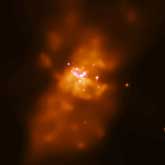Starburst, No, Not The Candy
 A starburst galaxy is a galaxy experiencing a period of intense star forming activity. Although this activity may last for ten million years or more, that is like a month in the life of a ten billion year old galaxy. During a starburst, stars can form at tens, even hundreds of times greater rates than the star formation rate in normal galaxies. Many of these newly formed stars are very massive and very bright, so starburst galaxies are among the most luminous galaxies.
A starburst galaxy is a galaxy experiencing a period of intense star forming activity. Although this activity may last for ten million years or more, that is like a month in the life of a ten billion year old galaxy. During a starburst, stars can form at tens, even hundreds of times greater rates than the star formation rate in normal galaxies. Many of these newly formed stars are very massive and very bright, so starburst galaxies are among the most luminous galaxies.
The burst occurs over a region a few thousand light years in diameter. The most popular theory for the cause of a starburst is that it is triggered by a close encounter or collision with another galaxy. This collision sends shock waves rushing through the galaxy. These shock waves push on giant clouds of gas and dust, causing them to collapse and form a few hundred stars. The massive stars use up their fuel quickly and explode as supernovas, which produce more shock waves and more star formation. In this way, a chain reaction of star formation and supernovas can sweep through the central region of a galaxy, where most of the gas is located. When most of the gas is used up or blown away by the explosions, the starburst ends.
The infrared satellite IRAS discovered thousands of starburst galaxies. Many of the new stars remain surrounded by dust and gas for a million years. Their light is absorbed by the dust, which radiates away the heat as infrared radiation. The 'heat radiation' produced by hot sidewalks on a summer day is infrared radiation. Starburst galaxies are rare among nearby galaxies, but they were common many billions of years ago. The universe is expanding, so galaxies were much closer together in the past and collisions or close encounters were more frequent, causing more starbursts.
About the Author
Chandra X-Ray Observatory Center
 The Chandra X-ray Observatory, previously known as the Advanced X-ray Astrophysics Facility, is a Flagship-class space telescope launched aboard the Space Shuttle Columbia during STS-93 by NASA on July 23, 1999.
The Chandra X-ray Observatory, previously known as the Advanced X-ray Astrophysics Facility, is a Flagship-class space telescope launched aboard the Space Shuttle Columbia during STS-93 by NASA on July 23, 1999.


